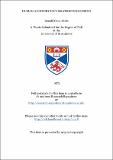Files in this item
Human auditory information processing
Item metadata
| dc.contributor.advisor | Jeeves, Malcolm A. | |
| dc.contributor.author | Hicks, Ronald G. | |
| dc.coverage.spatial | 210 p. | en_US |
| dc.date.accessioned | 2018-07-09T11:13:25Z | |
| dc.date.available | 2018-07-09T11:13:25Z | |
| dc.date.issued | 1973 | |
| dc.identifier.uri | https://hdl.handle.net/10023/15118 | |
| dc.description.abstract | The purpose of this study is to investigate the flow of nonsymbolic auditory information in humans. To achieve this goal the observer adjusts the loudness of a Gaussian noise (GN) signal to match the perceived intensity of an electrodermal stimulus (EDS), a cross-modality matching task. The loudness of the GN and the voltage of the EDS mere maintained within the observer's (O's) sensory probabilistic zone. The sensory probabilistic zone is a range of stimulus intensity from somewhere above "no detection" to "100% detection". The independent variable is a binary condition in that it consisted of catch trials of the time and the remaining time of an EDS at a given intensity (previously determined at an intensity that elicited a response 50% of the time). Consequently, the O's adjustment of the GN reflected his decision-making processes, analysed by signal detection theory and cybernetics. Experiment one demonstrated that neither practice nor the experimenter influenced the O's performance. Also, there are no residual carry-over effects. The 0 has difficulty assigning relative value to the auditory signals and has little or no difficulty in combining, organizing or co-ordinating the auditory information. The second experiment demonstrated that the O's difficulty in assigning relative value to the signals is due to a short memory retention of the nonsymbolic auditory signals (half-life of less than a second). However, verbal confidence ratings (VCRs) add persistency to the auditory memory (echoic memory), its half-life is extended to about 3.1 seconds. The VCR has a half-life of about four seconds. Experiment three demonstrated that nonsymbolic auditory information processing is not affected by interfering signals. From a cybernetic model of the results it is concluded that nonsymbolic auditory information is processed by a filtered, single channel, series processor. Persistency is added to the system's memory component by an interaction between the auditory (echoic) memory and the conceptual symbolic system (VCR). | en_US |
| dc.language.iso | en | en_US |
| dc.publisher | University of St Andrews | |
| dc.subject.lcc | BF251.H5 | |
| dc.subject.lcsh | Auditory perception | en |
| dc.title | Human auditory information processing | en_US |
| dc.type | Thesis | en_US |
| dc.type.qualificationlevel | Doctoral | en_US |
| dc.type.qualificationname | PhD Doctor of Philosophy | en_US |
| dc.publisher.institution | The University of St Andrews | en_US |
This item appears in the following Collection(s)
Items in the St Andrews Research Repository are protected by copyright, with all rights reserved, unless otherwise indicated.

